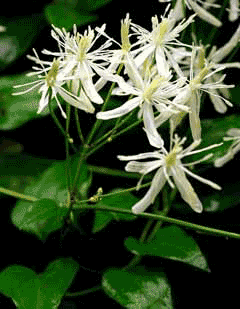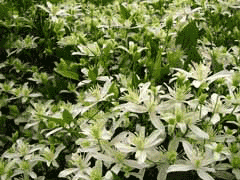 |
|
http://flickr.com/photos/autanex/2124270074/ |
 |
| http://www.flickr.com/photos/audreyjm529/239627842/ |
Translate this page:
Summary
Bloom Color: White.
Main Bloom Time: Early fall, Mid fall. Form: Upright or erect.
Physical Characteristics

 Clematis terniflora is a PERENNIAL CLIMBER growing to 5 m (16ft 5in) at a fast rate.
Clematis terniflora is a PERENNIAL CLIMBER growing to 5 m (16ft 5in) at a fast rate.
See above for USDA hardiness. It is hardy to UK zone 6. It is in flower from September to October, and the seeds ripen from October to November. The species is hermaphrodite (has both male and female organs) and is pollinated by Bees, flies.
Suitable for: light (sandy), medium (loamy) and heavy (clay) soils and prefers well-drained soil. Suitable pH: mildly acid, neutral and basic (mildly alkaline) soils and can grow in very alkaline soils.
It can grow in semi-shade (light woodland) or no shade. It prefers moist soil.
UK Hardiness Map
US Hardiness Map
Synonyms
C. maximowicziana. Franch.&Savat. C. paniculata. Thunb. non Gmel.
Plant Habitats
Woodland Garden Dappled Shade; Shady Edge;
Edible Uses
Edible Parts: Flowers Leaves Shoots
Edible Uses:
Young shoots - cooked[105, 177]. Parboiled, then eaten boiled or oil-roasted[183]. Some caution is advised, see the notes above on toxicity. The young buds (Does this refer to flower or leaf buds?) are parboiled then eaten boiled or oil-roasted, or they can be pickled in vinegar[183]. Flowers[105, 183]. No more details are given.
References More on Edible Uses
Medicinal Uses
Plants For A Future can not take any responsibility for any adverse effects from the use of plants. Always seek advice from a professional before using a plant medicinally.
Antidote Antiscrophulatic Ophthalmic
Antidote, antiscrofulatic, ophthalmic. Used in the treatment of corneal opacities[178].
References More on Medicinal Uses
The Bookshop: Edible Plant Books
Our Latest books on Perennial Plants For Food Forests and Permaculture Gardens in paperback or digital formats.

Edible Tropical Plants
Food Forest Plants for Hotter Conditions: 250+ Plants For Tropical Food Forests & Permaculture Gardens.
More

Edible Temperate Plants
Plants for Your Food Forest: 500 Plants for Temperate Food Forests & Permaculture Gardens.
More

More Books
PFAF have eight books available in paperback and digital formats. Browse the shop for more information.
Shop Now
Other Uses
As an ornamental but can be invasive so plant with care. It's a vigorous climber.
Special Uses
References More on Other Uses
Cultivation details
Landscape Uses:Arbor, Ground cover, Specimen. Prefers a deep moist soil in a sunny position[200]. Dislikes poorly-drained heavy clay soils, but grows well in clay if grit is added for drainage[11, 200]. Dislikes light sandy soils[11]. Does well on chalk[1]. Succeeds in acid as well as alkaline soils[200]. This species has the potential to spread from cultivation in areas where it has been introduced and could become problematic[274]. When planting out, in order to avoid the disease 'clematis wilt', it is best to plant the rootball about 8cm deeper in the soil. This will also serve to build up a good root crown of growth buds[200]. Plants seem to be immune to the predations of rabbits[233]. A greedy plant, inhibiting the growth of nearby plants, especially legumes[54]. Special Features:Attractive foliage, Not North American native, All or parts of this plant are poisonous, Fragrant flowers, Attractive flowers or blooms.
References Carbon Farming Information and Carbon Sequestration Information
Temperature Converter
Type a value in the Celsius field to convert the value to Fahrenheit:
Fahrenheit:
The PFAF Bookshop
Plants For A Future have a number of books available in paperback and digital form. Book titles include Edible Plants, Edible Perennials, Edible Trees,Edible Shrubs, Woodland Gardening, and Temperate Food Forest Plants. Our new book is Food Forest Plants For Hotter Conditions (Tropical and Sub-Tropical).
Shop Now
Plant Propagation
Seed - best sown as soon as it is ripe in a cold frame[164, 200]. Sow stored seed as soon as it is obtained in a cold frame. Pre-soak the seed for 12 hours in warm water and remove as much of the tail and outer coat as possible[164]. A period of cold stratification is beneficial[164]. The seed germinates in 1 - 9 months or more at 20°c[164]. Prick out the seedlings into individual pots when they are large enough to handle and grow them on in a cold frame for their first winter. Plant out in late spring or early summer, after the last expected frosts. Internodal cuttings of soft to semi-ripe wood, late spring in sandy soil in a frame[200]. Layering of old stems in late winter or early spring[200]. Layering of current seasons growth in early summer[200].
Other Names
If available other names are mentioned here
Sweet Autumn Clematis, leatherleaf clematis,
yam-leaved clematis,
Sennin-so,
Native Range
TEMPERATE ASIA: Mongolia, Russian Federation (Primorye, Amur), China (Anhui Sheng, Heilongjiang Sheng, Henan Sheng, Hubei Sheng, Hunan Sheng, Jiangsu Sheng, Jiangxi Sheng, Jilin Sheng, Liaoning Sheng, Nei Mongol Zizhiqu, Shaanxi Sheng, Shanxi Sheng, Zhejiang Sheng), Korea, Japan (Hokkaidô, Honshu, Kyushu, Shikoku), Taiwan
Weed Potential
Right plant wrong place. We are currently updating this section.
Please note that a plant may be invasive in one area but may not in your area so it's worth checking.
This plant can be weedy or invasive.
Conservation Status
IUCN Red List of Threatened Plants Status : This taxon has not yet been assessed.

Growth: S = slow M = medium F = fast. Soil: L = light (sandy) M = medium H = heavy (clay). pH: A = acid N = neutral B = basic (alkaline). Shade: F = full shade S = semi-shade N = no shade. Moisture: D = dry M = Moist We = wet Wa = water.
Now available:
Food Forest Plants for Mediterranean Conditions
350+ Perennial Plants For Mediterranean and Drier Food Forests and Permaculture Gardens.
[Paperback and eBook]
This is the third in Plants For A Future's series of plant guides for food forests tailored to
specific climate zones. Following volumes on temperate and tropical ecosystems, this book focuses
on species suited to Mediterranean conditions—regions with hot, dry summers and cool, wet winters,
often facing the added challenge of climate change.
Read More
Expert comment
Author
DC.
Botanical References
1158200
Links / References
For a list of references used on this page please go here
Readers comment
| Add a comment |
|
If you have important information about this plant that may help other users please add a comment or link below. Only comments or links that are felt to be directly relevant to a plant will be included. If you think a comment/link or information contained on this page is inaccurate or misleading we would welcome your feedback at [email protected]. If you have questions about a plant please use the Forum on this website as we do not have the resources to answer questions ourselves.
* Please note: the comments by website users are not necessarily those held by PFAF and may give misleading or inaccurate information.
To leave a comment please Register or login here All comments need to be approved so will not appear immediately.
|
Subject : Clematis terniflora
|
|
|
|